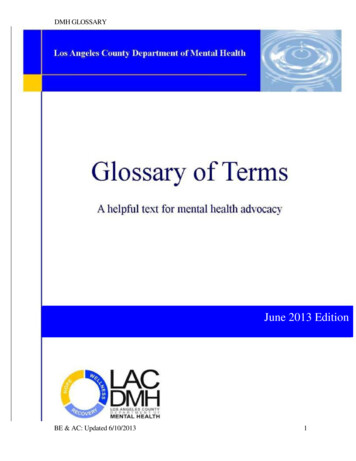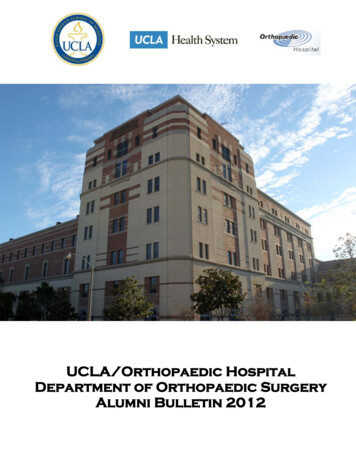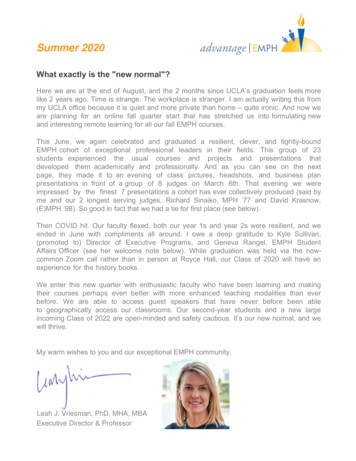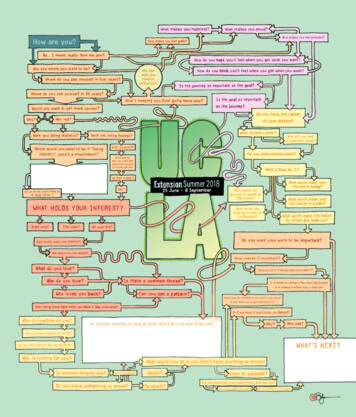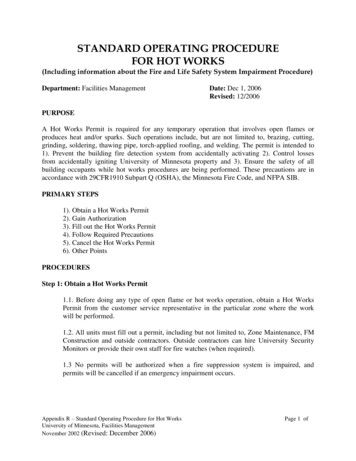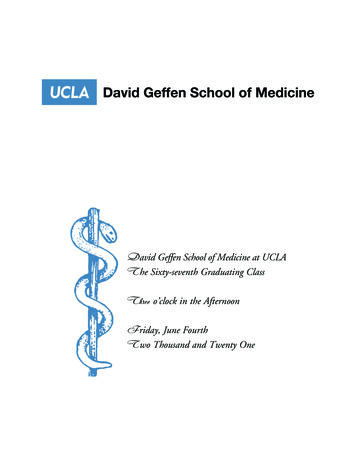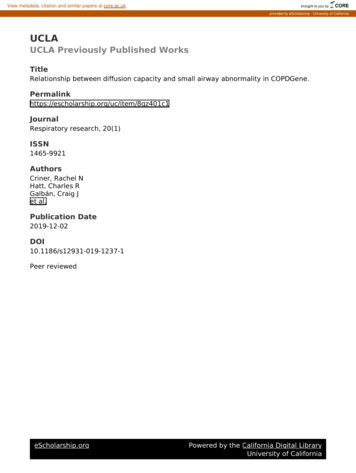
Transcription
View metadata, citation and similar papers at core.ac.ukbrought to you byCOREprovided by eScholarship - University of CaliforniaUCLAUCLA Previously Published WorksTitleRelationship between diffusion capacity and small airway abnormality in /8qz401c1JournalRespiratory research, 20(1)ISSN1465-9921AuthorsCriner, Rachel NHatt, Charles RGalbán, Craig Jet al.Publication Date2019-12-02DOI10.1186/s12931-019-1237-1Peer reviewedeScholarship.orgPowered by the California Digital LibraryUniversity of California
Criner et al. Respiratory Research(2019) TER TO THE EDITOROpen AccessRelationship between diffusion capacityand small airway abnormality in COPDGeneRachel N. Criner1* , Charles R. Hatt2,3, Craig J. Galbán3, Ella A. Kazerooni3, David A. Lynch4,Meredith C. McCormack5, Richard Casaburi6, Neil R. MacIntyre7, Barry J. Make8, Fernando J. Martinez9,Wassim W. Labaki10, Jeffrey L. Curtis10,11 and Mei Lan K. Han10AbstractImpaired single breath carbon monoxide diffusing capacity (DLCO) is associated with emphysema. Small airwaysdisease (SAD) may be a precursor lesion to emphysema, but the relationship between SAD and DLCO isundescribed. We hypothesized that in mild COPD, functional SAD (fSAD) defined by computed tomography (CT)and Parametric Response Mapping methodology would correlate with impaired DLCO. Using data from eversmokers in the COPDGene cohort, we established that fSAD correlated significantly with lower DLCO among bothnon-obstructed and GOLD 1–2 subjects. The relationship between DLCO with CT-defined emphysema was presentin all GOLD stages, but most prominent in severe disease.Trial registration: NCT00608764. Registry: COPDGene. Registered 06 February 2008, retrospectively registered.Keywords: Diffusing capacity of the lung (DLCO), Small airways disease (SAD), Chronic obstructive pulmonarydisease (COPD), Parametric response mapping (PRM)IntroductionThe importance of small airways disease (SAD) inCOPD pathogenesis was first described by Hogg et al. inthe 1960s, who determined that peripheral resistancecontributes minimally to total airway resistance inhealthy lungs but significantly in emphysematous lungs[1]. Recent research using advanced computed tomography (CT) has further suggested that a CT metric forsmall airway disease (SAD) radiographically precedesemphysema development and is associated with subsequent FEV1 decline [2, 3].Diffusing capacity of the lung (DLCO) is a commonlytested measurement in pulmonary function studies, indirectly measuring degree of gas transfer from alveoli topulmonary capillary blood, with results depending onthe lung’s structural and functional properties. Emphysema irreversibly destroys alveoli, leading to gas exchange impairment and manifesting as an inverserelationship between emphysema severity and DLCO[4]. We hypothesized that CT defined SAD among* Correspondence: rachel.criner@pennmedicine.upenn.edu1Division of Pulmonary, Allergy and Critical Care, University of Pennsylvania,839 West Gates Building, Philadelphia, PA 19104, USAFull list of author information is available at the end of the articleCOPD subjects with mild disease (GOLD 1–2) may detect lung regions in transition from bronchiolar pathology to emphysema, and hence, may be associated withdiffusion capacity impairment.MethodsWe analyzed data from the five-year follow-up visit ofthe COPDGene cohort in individuals (n 1846) with 10 pack-years smoking history and GOLD spirometricgrades 0–4 for whom DLCO and CT imaging data wereavailable and obtained on the same day. GOLD 0, although no longer used in the GOLD strategic document,includes non-obstructed smokers (post-bronchodilatorFEV1/FVC 0.7). COPDGene is a longitudinal, observational, and multicenter study investigating underlyinggenetic determinants of COPD (Clinicaltrials.gov identifier NCT00608764). DLCO was measured with EasyOnePro (serial number 500633, ndd Medizintechnik AG,Zurich, Switzerland). Percent predicted values and zscores were calculated from raw values using GlobalLung Function Initiative (GLI) equations. We processedinspiratory and expiratory CT images by parametric response mapping (PRM), a novel CT biomarker technique, using Imbio Lung Density Analysis dynamic The Author(s). 2019 Open Access This article is distributed under the terms of the Creative Commons Attribution 4.0International License (http://creativecommons.org/licenses/by/4.0/), which permits unrestricted use, distribution, andreproduction in any medium, provided you give appropriate credit to the original author(s) and the source, provide a link tothe Creative Commons license, and indicate if changes were made. The Creative Commons Public Domain Dedication o/1.0/) applies to the data made available in this article, unless otherwise stated.
Criner et al. Respiratory Research(2019) 20:269Page 2 of 4image registration software (Minneapolis, MN) to quantify areas of emphysema (PRMEmph) and areas of nonemphysematous gas trapping recently determined to beSAD (PRMfSAD) [5]. Multivariable regression models forDLCO GLI z-score were created to determine the relative contribution of PRMEmph and PRMfSAD, additionallyadjusted for age, sex, and current smoking.ResultsParticipant mean age at time of measurement was 67.0years. With increasing GOLD stage, DLCO % predictedfell and z-scores became more negative, while PRMEmphand PRMfSAD rose. These characteristics, as well as othersubject characteristics, are shown in Table 1.In a multivariable regression model examining nonobstructed ever-smokers, PRMfSAD (β 0.03, p 0.001)and PRMEmph (β 0.04, p 0.03) were associated withlower DLCO GLI z-score. For clinical interpretation, onaverage a non-obstructed individual with 10% higherPRMfSAD would be predicted to have 3.1% lower DLCO% predicted. In GOLD 1–2, both PRMfSAD (β 0.02,p 0.004) and PRMEmph (β .10, p 0.008) were associated with lower DLCO GLI z-score. Among GOLD 3–4, PRMEmph (β 0.11, p 0.001) but not PRMfSAD(p 0.69) was associated with lower GLI z-score.Table 1 Baseline demographicsGOLD spirometry grade0 (n 957)1–2 (n 584)3–4 (n 305)Age, yr63.568.368.9Sex, n (% female)512 (54%)249 (42%)130 (43%)BMI (kg/m )28.927.927.5Smoking pack-years37.149.855.0Current smokers, n (%)344 (36%)212 (36%)61 (20%)Exacerbations in prior year0.110.320.712FEV1, L2.732.030.98FEV1% predicted98.473.336.4FVC, L3.493.392.43FVC % predicted96.191.767.2FEV1/FVC0.780.600.41DLCO, % predicted90.1%74.2%51.2%DLCO, GLI z-score 0.73 1.91 4.08PRMfSAD10.0%21.0%34.6%1.8%6.5%18.3%EmphPRMAll values expressed as mean except categorical variables expressed as n (%)BMI body mass index, FEV1 forced expiratory volume in 1 s, FVC forced vitalcapacity, DLCO single breath carbon monoxide diffusing capacity of the lung,GLI Global Lung Function Initiative, PRM parametric response mapping, fSADfunctional small airways disease, Emph emphysemaDiscussionOur analysis of a sizeable group of current and formersmokers indicate that in those without airflow obstruction and in individuals with mild to moderate COPD,small airways disease defined by PRM is associated withsignificant gas exchange abnormalities. These data buildon and extend recent work to elucidate the nature ofsmall airway abnormality in COPD. The PRMfSAD metrichas been associated with more rapid lung function decline, even among individuals with emphysema [6].Using longitudinal image registration, we previouslyshowed that voxels identified as PRMfSAD radiographically precede development of CT-determined emphysemain those same voxels [7]. Importantly, we recently demonstrated with severe COPD human lung tissue thatPRMfSAD metric corresponds to pathologic abnormality,including decreased circularity, decreased luminal area,and complete obstruction of terminal bronchioles (TBr),whereas PRMEmph is significantly associated with decreased alveolar surface area [5].However, the pathology identified by PRMfSAD inmilder disease is unknown. Given the totality of datagenerated to date, PRMfSAD is also likely associated withTBr pathology in mild COPD, but the extent to which itmay also identify early alveolar destruction must bedetermined.The association we show here between PRMfSAD andreduced DLCO suggests that the fSAD metric may detect lung beginning to transition from bronchiolar pathology to emphysema.Support for this possibility comes from McDonoughet al., who used micro-CT to analyze lung tissue samplesin severe COPD. By identifying significantly reduced TBrnumbers in areas of lung without visible emphysema evidence, they inferred that narrowing and loss of TBr precedes emphysema [2]. However, a linear relationshipbetween loss of TBr and increase in mean linear intercept (a measure of mean free distance in the air spaces)was seen. Most recently, Koo et al. examined lung tissuefrom GOLD 1–2 stage disease and again found significant reductions in number of TBr and transitional bronchioles in lung areas without visible emphysema [3].Collectively, these results support SAD as one precursorof emphysema.DLCO is well-established to correlate with CTdetermined emphysema [4], but it may also be decreasedin mild COPD, where emphysema is not detectable byCT imaging. Active smokers with normal spirometry butlow DLCO had increased rate of progression to GOLDdefined COPD, compared to smokers with normal spirometry and normal DLCO, implying that isolated decreased DLCO is a risk factor for airflow obstruction inotherwise healthy subjects [8]. Ex-smokers with normalCTs and no airflow obstruction but with low DLCO had
Criner et al. Respiratory Research(2019) 20:269significantly worse symptoms and exercise capacity aswell as greater regional lung destruction, as measured byhyperpolarized 3He MRI apparent diffusion coefficients[9]. In 10 patients with severe SAD, defined by severeexpiratory airflow limitation with mild CT-detected emphysema, Gelb et al. found DLCO reductions; however,they proposed that this was possibly due to uneven gassampling from lung units with differing expiratory timeconstants, a function of SAD rather than lung parenchymal destruction [10].Our current analysis of ever-smokers without obstruction and with GOLD 1–2 COPD showed that PRMfSADcorrelates with low DLCO, suggesting PRMfSAD mightdetect airways transitioning to early emphysema withresulting impaired gas exchange. Although COPD is aheterogonous disease, it is possible that a significant portion of small airways disease patients will progress toemphysema. Therefore, in addition to already describingcorrelations between tissue pathology and PRMfSAD insevere disease, similar studies in milder disease are alsoneeded to confirm the pathology type identified in thispopulation, who may be more amenable to therapeuticintervention that may halt progression to emphysema.AbbreviationsCT: Computed tomography; DLCO: Diffusing capacity of the lung;fSAD: Functional small airways disease; GLI: Global Lung Function Initiative;PRM: Parametric response mapping; PRMEmph: Emphysema as determined byPRM; PRMfSAD: Small airways disease as determined by PRM; SAD: Smallairways disease; TBr: Terminal bronchiolesAcknowledgementsNot applicable.Authors’ contributionsConcept and design: MKH, RNC. Data analysis: MKH. Data interpretation:MKH, RNC. Manuscript drafting and editing: all authors (RNC, CRH, CJG, EAK,DAL, MCM, RC, NRM, BJM, FJM, WWL, JLC, MKH). Final approval of themanuscript: all authors (RNC, CRH, CJG, EAK, DAL, MCM, RC, NRM, BJM, FJM,WWL, JLC, MKH).FundingThis work was supported by NHLBI U01 HL089897 and U01 HL089856. TheCOPDGene study (NCT00608764) is also supported by the COPD Foundationthrough contributions made to an Industry Advisory Committee comprisedof AstraZeneca, Boehringer-Ingelheim, GlaxoSmithKline, Novartis, and Sunovion. Dr. Han is supported by NHLBI K24 HL138188. Dr. Curtis is supportedby I01 CX000911 from the Department of Veterans Affairs.Availability of data and materialsThe datasets used and analyzed during the current study are available fromthe corresponding author on reasonable request.Ethics approval and consent to participateThis research letter presents an analysis of the COPDGene study registeredon Clinicaltrials.gov (NCT00608764). The protocol was reviewed andapproved by the Institutional Review Boards for each participating center(National Jewish Health, HS-1883a; Brigham and Women’s Hospital, 2007-P000554/2; Baylor College of Medicine, H-22209; Michael E. DeBakey VAMC,H 22202; Columbia University Medical Center, IRB-AAAC9324; Duke UniversityMedical Center, Pro00004464; Johns Hopkins University, NA 00011524; LosAngeles Biomedical Research Institute, 12756–01; Morehouse School of Medicine, 07–1029; Temple University, 11369; University of Alabama at Birmingham, FO70712014; University of California, San Diego, 070876; University ofPage 3 of 4Iowa, 200710717; Ann Arbor VA, PCC 2008–110732; University of Minnesota,0801 M24949; University of Pittsburgh, RO07120059; University of TexasHealth Sciences Center at San Antonio, HSC20070644H; Health Partners Research Foundation, 07–127; University of Michigan, HUM00014973; Minneapolis VA Medical Center, 4128-A; Fallon Clinic, 1143).Consent for publicationNot applicable.Competing interestsRNC, EAK, NM, RC, WWL – none.CRH – An employee of and has stock options in Imbio LLC, which haslicensed the PRM technology for use as FDA-approved commercial software.DAL - Reports grants from NHLBI and has a pending patent entitled Systemsand Methods for Classifying Severity of COPD.CJG – Is co-inventor of PRM, which is licensed to Imbio by the University ofMichigan.MM – Reports other support from UpToDate.BM – Reports funding from the NHLBI for the COPDGene study; grants andmedical advisory boards from Boehringer Ingelheim, GlaxoSmithKline,AstraZeneca, and Sunovian; personal fees for DSMB from Spiration and Shire/Baxalta; CME personal fees from WebMD, National Jewish.Health, American College of Chest Physicians, Projects in Knowledge, HybridCommunications, SPIRE Learning, Ultimate Medical Academy, CatamountMedical, Eastern Pulmonary Society, Catamount Medical CommunicationsMedscape, Eastern VA Medical Center, Academy Continued HealthcareLearning, and Mt. Sinai Medical Center; royalties from Up-To-Date; medicaladvisory boards from Novartis, Phillips, Third Pole, Science 24/7, and Vernoa;and grants from Pearl.FJM - Receives personal fees and non-financial support from American College of Chest Physicians, AstraZeneca, Boehringer Ingelheim, ConCert, Genentech, GlaxoSmithKline, Inova Fairfax Health System, Miller Communications,National Association for Continuing Education, Novartis, Pearl Pharmaceuticals, PeerView Communications, Prime Communications Puerto Rican Respiratory Society, Chiesi, Sunovion, Theravance, Physicians EducationResource, Canadian Respiratory Network, Teva, and Dartmouth. Receivesnon-financial support from ProterrixBio, Gilead, Nitto, Potomac, University ofAlabama Birmingham, and Zambon. Receives personal fees from ColumbiaUniversity, Integritas, MD Magazine, Methodist Hospital Brooklyn, New YorkUniversity, UpToDate, WebMD/MedScape, Western Connecticut Health Network, Patara/Respivant, PlatformIQ, American Thoracic Society, Rockpointe,Rare Disease Healthcare Communications, and France Foundation. He receives grants from the NIH. He also receives other support from Afferent/Merck, Biogen, Veracyte, Prometic, Bayer, Bridge Biotherapeutics, andProMedior.JLC - Reports grants from NIH/NHLBI, NIH/NIAID, the Department of VeteransAffairs, and the Department of Defense.MKH - Reports grants from NIH, personal fees from BI, GSK, AZ, and Mylan.She also receives other support from Novartis and Sunovion.Author detailsDivision of Pulmonary, Allergy and Critical Care, University of Pennsylvania,839 West Gates Building, Philadelphia, PA 19104, USA. 2Imbio, LLC,Minneapolis, MN, USA. 3Department of Radiology, University of Michigan,Ann Arbor, MI, USA. 4Department of Radiology, National Jewish Health,Denver, CO, USA. 5Division of Pulmonary & Critical Care Medicine, JohnsHopkins Medicine, Baltimore, MD, USA. 6Rehabilitation Clinical Trials Center,Los Angeles Biomedical Research Institute at Harbor-UCLA Medical Center,Torrance, CA, USA. 7Division of Pulmonary, Allergy and Critical Care Medicine,Duke University, Durham, NC, USA. 8Division of Pulmonary, Critical Care, andSleep Medicine, National Jewish, Denver, CO, USA. 9Division of Pulmonary &Critical Care Medicine, Weill Cornell Medical College, New York, NY, USA.10Division of Pulmonary & Critical Care Medicine, University of Michigan, AnnArbor, MI, USA. 11VA Ann Arbor Healthcare System, Ann Arbor, MI, USA.1Received: 21 September 2019 Accepted: 8 November 2019References1. Hogg JC, Macklem PT, Thurlbeck WM. Site and nature of airway obstructionin chronic obstructive lung disease. N Engl J Med. 1968;278:1355–60.
Criner et al. Respiratory Research(2019) 20:2692.McDonough JE, Yuan R, Suzuki M, Seyednejad N, Elliott WM, Sanchez PG,Wright AC, Gefter WB, Litzky L, Coxson HO, et al. Small-airway obstructionand emphysema in chronic obstructive pulmonary disease. N Engl J Med.2011;365:1567–75.3. Koo HK, Vasilescu DM, Booth S, Hsieh A, Katsamenis OL, Fishbane N, ElliottWM, Kirby M, Lackie P, Sinclair I, et al. Small airways disease in mild andmoderate chronic obstructive pulmonary disease: a cross-sectional study.Lancet Respir Med. 2018;6:591–602.4. D'Anna SE, Asnaghi R, Caramori G, Appendini L, Rizzo M, Cavallaro C, MarinoG, Cappello F, Balbi B, Di Stefano A. High-resolution computed tomographyquantitation of emphysema is correlated with selected lung function valuesin stable COPD. Respiration. 2012;83:383–90.5. Vasilescu DM, Martinez FJ, Marchetti N, Galban CJ, Hatt C, Meldrum CA, DassC, Tanabe N, Reddy RM, Lagstein A, et al. Non-invasive imaging biomarkeridentifies small airway damage in severe COPD. Am J Respir Crit Care Med.2019;200:575–81.6. Bhatt SP, Soler X, Wang X, Murray S, Anzueto AR, Beaty TH, Boriek AM,Casaburi R, Criner GJ, Diaz AA, et al. Association between functional smallairway disease and FEV1 decline in chronic obstructive pulmonary disease.Am J Respir Crit Care Med. 2016;194:178–84.7. Labaki WW, Gu T, Murray S, Hatt CR, Galban CJ, Ross BD, Martinez CH, CurtisJL, Hoffman EA, Pompe E, et al. Voxel-wise longitudinal parametric responsemapping analysis of chest computed tomography in smokers. Acad Radiol.2019;26:306–12.8. Harvey B-G, Strulovici-Barel Y, Kaner RJ, Sanders A, Vincent TL, Mezey JG,Crystal RG. Risk of COPD with obstruction in active smokers with normalspirometry and reduced diffusion capacity. Eur Respir J. 2015;46:1589–97.9. Kirby M, Owrangi A, Svenningsen S, Wheatley A, Coxson HO, Paterson NAM,McCormack DG, Parraga G. On the role of abnormal DLCO in ex-smokerswithout airflow limitation: symptoms, exercise capacity and hyperpolarisedhelium-3 MRI. Thorax. 2013;68:752–9.10. Gelb AF, Zamel N, Hogg JC, Müller NL, Scheiin MJ. Pseudophysiologicemphysema resulting from severe small-airways disease. Am J Respir CritCare Med. 1998;158:815–9.Publisher’s NoteSpringer Nature remains neutral with regard to jurisdictional claims inpublished maps and institutional affiliations.Page 4 of 4
fell and z-scores became more negative, while PRMEmph and PRMfSAD rose. These characteristics, as well as other subject characteristics, are shown in Table 1. In a multivariable regression model examining non-obstructed ever-smokers, PRMfSAD (β 0.03, p 0.001) and PRMEmph (β 0.


